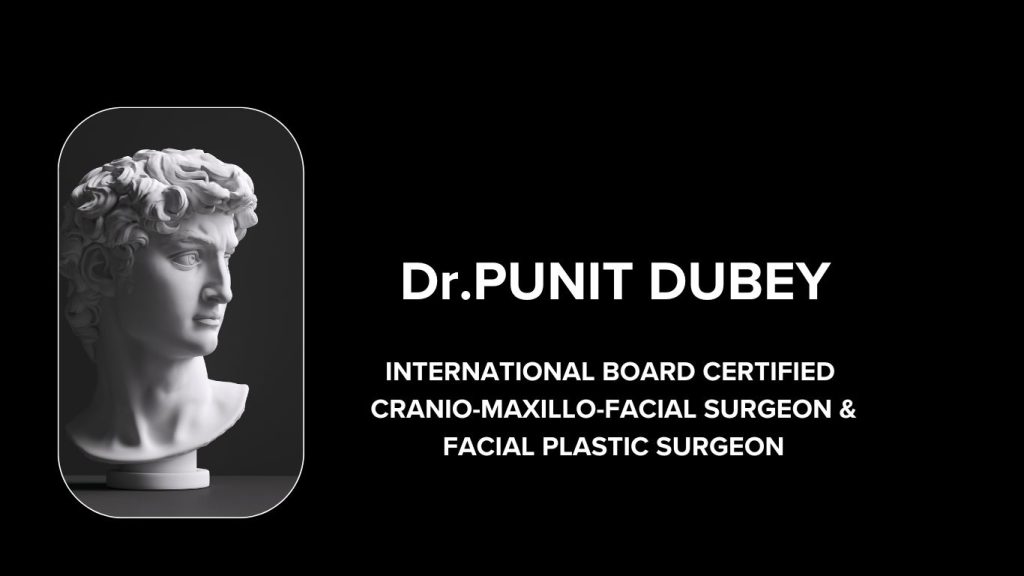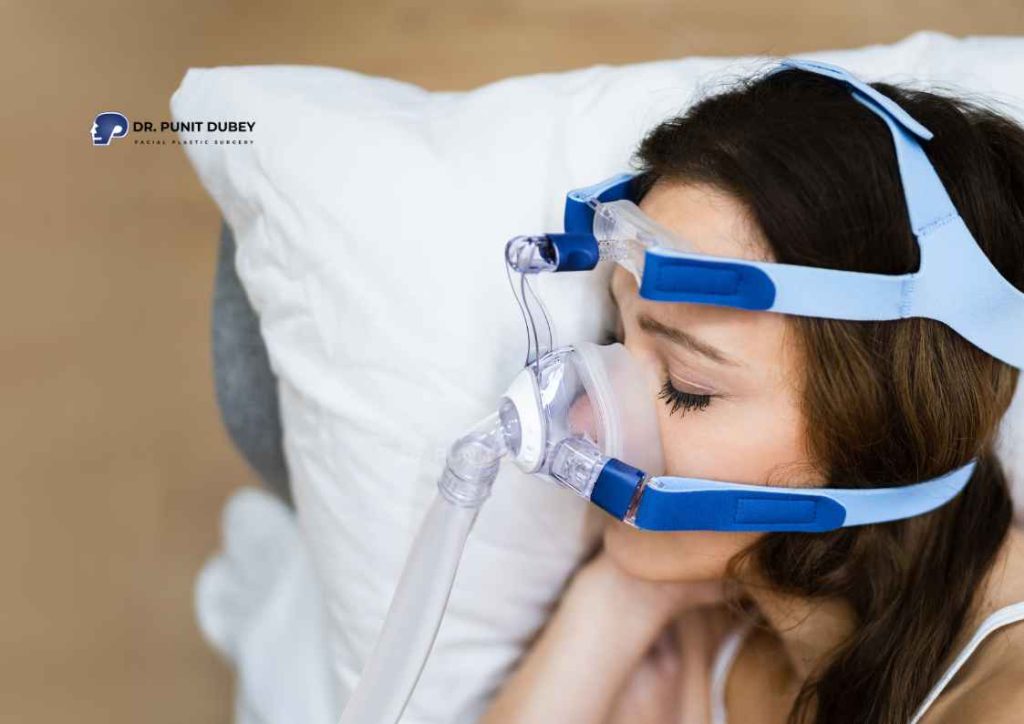
Obstructive Sleep Apnea Treatment in Delhi, India
If you’ve been waking up tired, gasping for air at night, or your partner constantly complains about your loud snoring — it might not just be poor sleep hygiene. You could be dealing with obstructive sleep apnea (OSA) — a serious, chronic condition that disrupts your breathing while you sleep. Thankfully, with obstructive sleep apnea treatment in Delhi, India, there are now advanced solutions available — including jaw surgery like Maxillomandibular Advancement (MMA) that can actually cure OSA in many patients.
Whether you’re suffering from mild, moderate, or severe obstructive sleep apnea, this guide will walk you through everything — from causes and symptoms to permanent surgical solutions like double jaw surgery and what recovery looks like, all with a spotlight on Dr. Punit Dubey, one of India’s leading experts in jaw surgery for sleep apnea.
Table of Contents
What is Obstructive Sleep Apnea?
Imagine falling asleep only to have your own body wake you up—over and over—because it can’t breathe properly. This is exactly the scenario experienced in cases of obstructive sleep apnea, where breathing repeatedly stops during sleep due to a blocked airway. It’s a common yet underdiagnosed sleep disorder where your upper airway becomes partially or completely blocked during sleep, leading to repeated breathing pauses (apneas).
Each time this happens, your brain momentarily wakes you up to reopen the airway, interrupting your deep sleep cycle — sometimes hundreds of times in a single night.
Obstructive Sleep Apnea Meaning
The term “obstructive” describes a mechanical blockage that prevents normal airflow through the breathing passages. Unlike central sleep apnea, which stems from neurological misfiring, OSA is mechanical — caused by the collapse or narrowing of structures like the soft palate, tongue base, or throat muscles.
Obstructive Sleep Apnea Syndrome (OSAS)
This term is often used interchangeably with OSA and includes not just breathing disturbances but also related health complications such as:
- Daytime sleepiness
- Poor concentration
- Mood swings
- High blood pressure
- Heart rhythm disturbances
In both adults and children, untreated OSA can affect mental performance, behavior, and long-term cardiovascular health.
Types of Obstructive Sleep Apnea
- Mild OSA: 5–15 apnea episodes per hour
- Moderate OSA: 15–30 episodes per hour
- Severe OSA: 30+ episodes per hour (often the most dangerous and disruptive)
Severity is measured using the Apnea-Hypopnea Index (AHI) during a sleep study.
Obstructive Sleep Apnea Causes
You might wonder — why does the airway collapse during sleep in the first place? The answer often lies in the anatomy of the upper airway and certain contributing risk factors.
What Causes Obstructive Sleep Apnea?
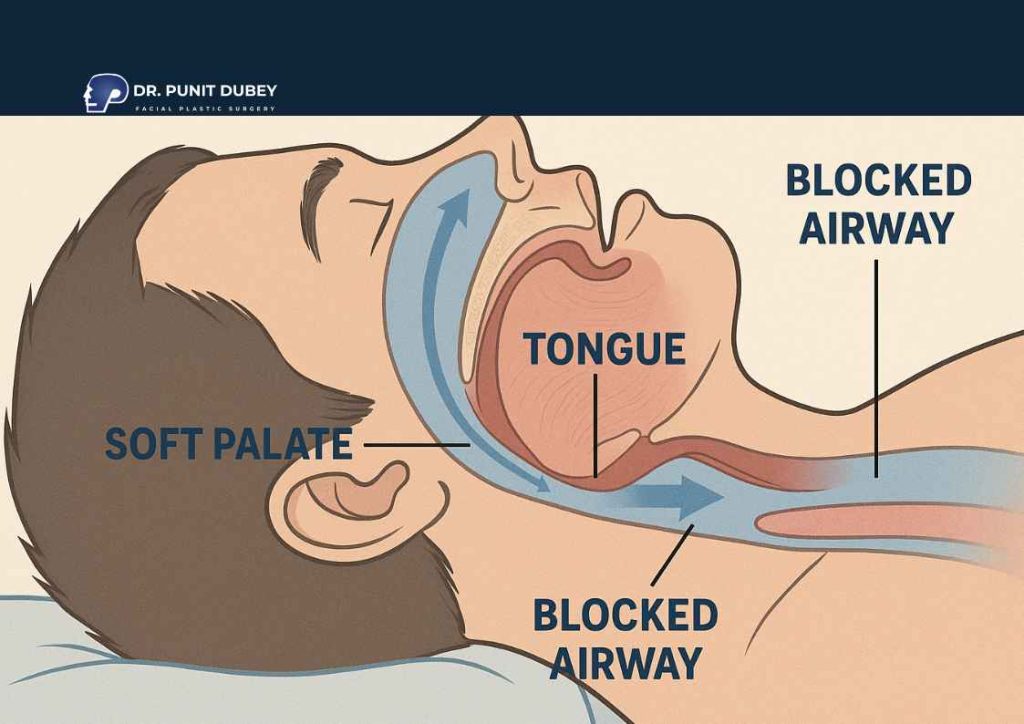
At its core, obstructive sleep apnea is caused by a physical blockage of airflow despite continued breathing effort. This obstruction can happen due to:
- Oversized tonsils or adenoids, particularly common in pediatric cases
- Thick neck or excess fat around the airway
- Retrognathia (receded lower jaw or chin)
- Large tongue (macroglossia) or low muscle tone in the tongue and throat
- Soft palate collapse or elongated uvula
- Nasal blockages, deviated septum, or chronic allergies
- Uncommon growths like cysts or tumors that partially block the airway
Sites of Obstruction in the Upper Airway
Obstructions can occur at one or more of these key anatomical sites:
- Nasal Cavity: Deviated septum, nasal polyps
- Soft Palate & Uvula: Often collapses backward during sleep
- Tonsil Area: Swollen tonsils can significantly reduce space in the oropharyngeal region
- Tongue Base: The tongue can shift backward during sleep, obstructing airflow
- Hypopharynx: Collapse of the lower throat walls
- Jaw Structure: A small or recessed jaw reduces space for the tongue and soft tissues
Contributing Conditions That Elevate the Risk of Developing OSA
While anyone can develop OSA, the risk increases with:
- Obesity (BMI > 30)
- Male gender (though post-menopausal women also at high risk)
- Age > 40
- Family history of OSA
- Alcohol or sedative use before bedtime
- Smoking
- Medical conditions like hypothyroidism or PCOS
Even infants and children can experience OSA due to congenital anomalies, large adenoids, or craniofacial syndromes.
Obstructive Sleep Apnea Symptoms
Do you often wake up feeling tired despite spending enough hours in bed? Or perhaps you’ve been told you snore like a freight train? These aren’t just sleep quirks — they could be red flags for obstructive sleep apnea symptoms that shouldn’t be ignored.
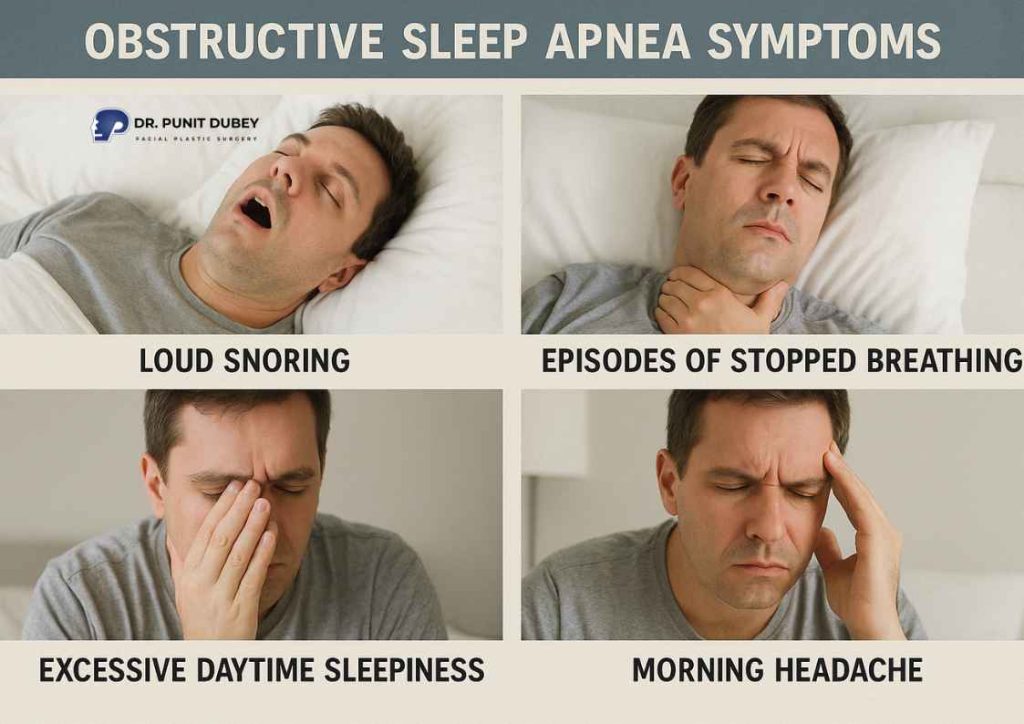
Common Symptoms of Obstructive Sleep Apnea
While symptoms can vary from person to person, here are the most frequently reported signs of OSA:
- Persistent, heavy snoring that may include interruptions or gasping
- Gasping for air during sleep
- Excessive daytime sleepiness (even after 7–8 hours of sleep)
- Morning headaches
- A dry mouth or scratchy throat in the morning after sleep
- Difficulty concentrating / brain fog
- Mood changes, irritability, or depression
- Decreased libido
- Insomnia or frequent nighttime awakenings
- Witnessed apneas (your partner may notice you stop breathing)
Obstructive Sleep Apnea in Children
In kids, symptoms may appear different and include:
- Mouth breathing
- Restless sleep / bed-wetting
- Behavioral issues or poor academic performance
- Enlarged tonsils or adenoids
Many parents overlook these signs, mistaking them for ADHD or sleepwalking — but early intervention can prevent long-term developmental and health issues.
Severe Obstructive Sleep Apnea Symptoms
When OSA is left untreated and becomes severe, complications can include:
- High blood pressure
- Heart arrhythmias
- Increased risk of stroke or heart attack
- Type 2 diabetes
- Pulmonary hypertension
- Cognitive impairment or memory loss
The danger here isn’t just poor sleep — it’s life-threatening health risks that grow with time.
OSA Diagnosis
Diagnosing obstructive sleep apnea isn’t based on snoring alone. While snoring is a common symptom, a clinical diagnosis of OSA requires structured evaluation and testing. The process includes a detailed medical history, physical examination, and often a sleep study to assess the Apnea-Hypopnea Index (AHI).
Medical History and Symptom Evaluation
A specialist will begin by asking about:
- Sleep quality and duration
- Daytime fatigue or drowsiness
- Frequency and severity of snoring
- Episodes of breathlessness during sleep
- Observed apneas (if reported by a partner)
- Lifestyle habits like alcohol consumption, smoking, or sedative use
In children, behavioral symptoms and growth concerns are also explored.
Clinical Examination
The physical exam focuses on:
- Airway anatomy (nasal obstruction, deviated septum, enlarged tonsils/adenoids)
- Jaw alignment (receded chin, overbite)
- Neck circumference
- BMI and weight-related risk factors
Polysomnography (Sleep Study)
The gold standard for diagnosing OSA is a polysomnography — an overnight sleep study conducted in a lab or via a home-based system. It records:
- Brain activity
- Eye movements
- Muscle tone
- Heart rate
- Oxygen levels
- Chest/abdominal movement
- Airflow and snoring sounds
Results help classify OSA severity using the Apnea-Hypopnea Index (AHI):
- Mild: 5–14 events per hour
- Moderate: 15–29 events per hour
- Severe: 30+ events per hour
Other Diagnostic Tools
- Home Sleep Apnea Testing (HSAT): Suitable for uncomplicated cases
- Cephalometric X-rays: To evaluate jaw and airway anatomy
- Drug-Induced Sleep Endoscopy (DISE): Helps identify specific sites of obstruction
- 3D airway CT scans or CBCT imaging: Often used before jaw surgery planning
Ideal Candidates for Obstructive Sleep Apnea Treatment
Not everyone with obstructive sleep apnea requires surgery, but certain individuals may benefit greatly from more advanced treatments — especially when CPAP (Continuous Positive Airway Pressure) fails or isn’t tolerated.
When Should You Consider Advanced Treatment?
You may be an ideal candidate for surgical or long-term corrective treatment if you:
- Experience a clinically diagnosed moderate to severe level of obstructive sleep apnea
- Cannot tolerate or refuse to use a CPAP machine
- Have a receded lower jaw (retrognathia) contributing to airway blockage
- Have documented anatomic obstruction confirmed by imaging or sleep endoscopy
- Have failed other treatments like weight loss, oral appliances, or positional therapy
- Are seeking a curative solution rather than long-term device dependency
Who Benefits the Most from Jaw Surgery for OSA?
Jaw surgery, specifically Maxillomandibular Advancement (MMA), is most effective in:
- Patients with small jawbones, overbite, or retruded maxilla/mandible
- Patients with tongue-based obstruction
- Individuals whose sleep apnea stems from jawbone structure instead of solely soft tissue issues
- People with high AHI scores who want to reverse the root structural cause
It is also highly recommended for patients who wish to reduce their long-term cardiovascular risks and eliminate dependence on machines like CPAP.
Contraindications and Cautions
Surgery may not be appropriate for:
- Patients with poorly controlled medical conditions
- Those unwilling to follow postoperative care instructions
- Individuals with psychiatric disorders that impact compliance
A multidisciplinary team will determine suitability after comprehensive evaluation.
The Process of Maxillomandibular Advancement Surgery for Obstructive Sleep Apnea Treatment in Delhi
When lifestyle changes and CPAP aren’t enough, Maxillomandibular Advancement (MMA) surgery along with genioplasty offers a permanent, structural solution to obstructive sleep apnea. This advanced jaw surgery works by enlarging the airway space, reducing obstruction, and restoring normal breathing during sleep.
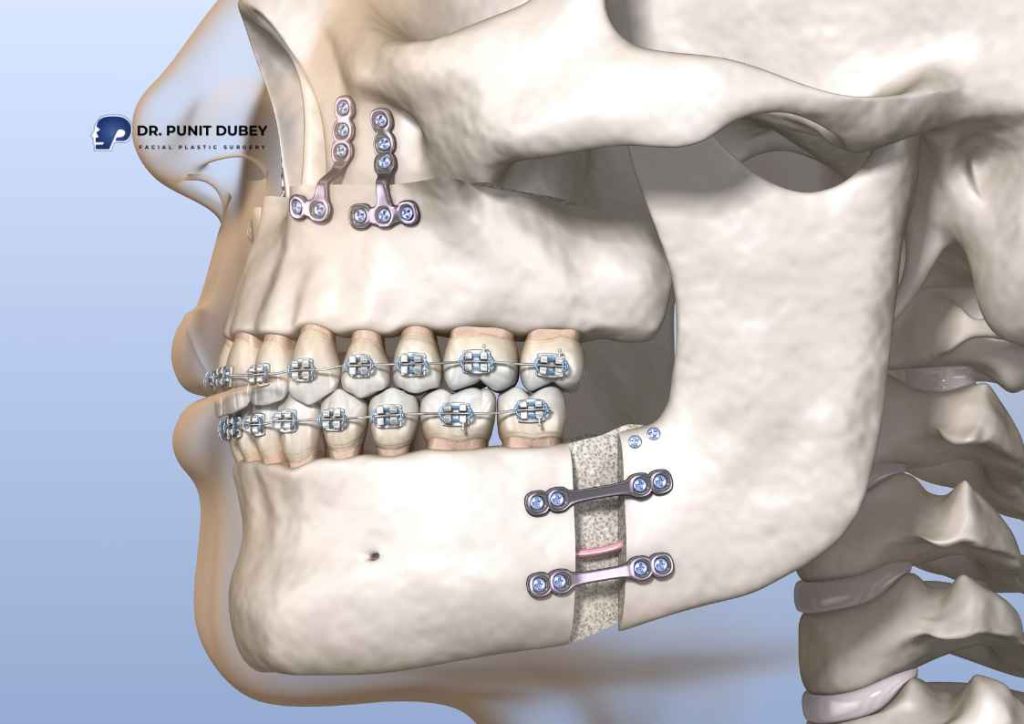
Below is a step-by-step breakdown of the treatment process, especially when done under expert care in Delhi.
Initial Consultation
Your journey begins with a thorough clinical evaluation, where the surgeon assesses your:
- AHI score and sleep study report
- Airway anatomy through CT or CBCT scans
- Jaw positioning and occlusion
- History of failed CPAP or oral appliance use
Photographs, cephalometric analysis, and sometimes 3D facial scans are taken to understand the skeletal deficiency contributing to OSA.
Pre-Surgery Preparations
Once you’re deemed a candidate, pre-operative steps include:
- Blood work and medical clearance
- Pre-surgical orthodontics (if required)
- Planning virtual surgical simulation using imaging
- Counseling for postoperative expectations and downtime
You’re also educated on post-surgical dietary restrictions, wound care, and expected recovery trajectory.
Maxillomandibular Advancement for Obstructive Sleep Apnea
In Maxillomandibular Advancement (MMA), both the upper and lower jaws are surgically advanced to enlarge the space within the airway and improve airflow during sleep. This repositioning:
- Expands the posterior airway space
- Pulls the tongue base forward
- Improves nasal airflow and pharyngeal patency
During surgery:
- All surgical cuts are placed intraorally, ensuring no scars appear on the external facial skin
- The repositioned jaws are secured using medical-grade titanium screws and plates for long-term stability
- The operation is carried out under general anesthesia and typically lasts anywhere from three to five hours, depending on the complexity.
This advancement significantly increases the airway volume, often eliminating or drastically reducing sleep apnea events.
Post-Surgery Recovery
- Hospital stays: Usually 2–3 days
- Swelling and tightness: Expected for 1–2 weeks
- Return to work: 2–3 weeks depending on your healing
- Nutrition: Patients are advised to stick to liquids or soft-textured foods during the initial four weeks of recovery
- Scheduled visits are conducted routinely to track recovery and verify that the jaws remain correctly aligned
Your surgeon may recommend a repeat sleep study 3–6 months post-op to measure AHI improvement.
Obstructive Sleep Apnea Surgery Procedure Summary
- Surgical name: Maxillomandibular Advancement (MMA), Genioplasty, if needed Rhinoplasty, Septoplasty Surgery, Facial Asymmetry Surgery
- Objective: Enlarge airway by advancing both jaws
- Outcome: Permanent structural improvement in OSA
- Success Rate: Over 85–90% for severe OSA in published studies
- Performed by: Maxillofacial surgeons specializing in airway-focused orthognathic surgery
Benefits of Double Jaw Surgery for Obstructive Sleep Apnea
When treating moderate to severe obstructive sleep apnea, especially in patients with skeletal deficiencies, double jaw surgery (Maxillomandibular Advancement) can be life-changing. Unlike temporary solutions like CPAP, this is a one-time structural correction that targets the root cause of airway obstruction.

- Permanent Airway Expansion
By advancing both the upper (maxilla) and lower (mandible) jaws forward, MMA surgery increases the airway space by up to 12 mm or more. This results in:
- Reduced soft tissue collapse
- Improved oxygen flow
- Fewer or no apneic episodes during sleep
- High Success Rate
Studies show MMA has a success rate of over 85–90%, particularly in patients with craniofacial structural anomalies. It’s currently the most effective surgical option for OSA when non-invasive therapies fail.
- Improved Quality of Life
Post-surgery, most patients report:
- Better sleep quality
- Increased daytime energy
- Elimination or significant reduction in CPAP dependence
- Improvement in mental clarity, fewer early morning headaches, and greater emotional stability
- Cardiovascular Benefits
By improving oxygenation during sleep, MMA surgery helps in:
- Lowering blood pressure
- Reducing strain on the heart
- Lowering the chances of developing cardiovascular conditions such as stroke and heart-related illnesses
- Facial Aesthetic Enhancement
An often-overlooked benefit is the improvement in facial harmony. Patients with retrognathic profiles or weak chins often notice a stronger jawline and more balanced midface after surgery — leading to both functional and aesthetic gains.
- No External Scars
Because the entire surgery is performed intraorally (through the mouth), patients enjoy all the benefits of major jaw surgery without visible scars on the face or neck.
Jaw Surgery Long-Term Side Effects
Although Maxillomandibular Advancement (MMA) offers a highly successful solution for treating obstructive sleep apnea, it remains an extensive and complex surgical intervention requiring careful consideration. Understanding potential risks and considerations helps you make an informed decision.
Common Surgical Risks
- Bleeding and bruising
- Infection at the surgical site
- Temporary or prolonged facial swelling
- Mild to moderate soreness after jaw surgery may persist during the initial weeks of recovery
- Mild speech changes during early recovery
These are typically manageable and improve with proper post-operative care.
In rare cases, patients may experience:
- Temporary or, in rare cases, lasting numbness in the chin or lower lip may occur as a result of nerve involvement during surgery.
- Changes in bite alignment requiring orthodontic follow-up
- Relapse or slight movement of jaw bones if post-op instructions aren’t followed
- TMJ (temporomandibular joint) discomfort or clicking
- Scar tissue formation internally
Choosing an experienced surgeon significantly reduces the chances of such issues.
Psychological and Lifestyle Considerations
- There’s a temporary lifestyle disruption during healing, particularly in the first 2–4 weeks
- Some patients may need speech therapy or bite adjustment afterward
These considerations are short-term and often worth the long-term benefit of restored, restful sleep.
Tips for Selecting the Best Jaw Surgeon in India
To minimize complications and maximize results:
- Choose a surgeon with formal training in orthognathic or cranio-maxillofacial surgery
- Look for specialists with experience in sleep apnea surgery, not just cosmetic jaw work
- Ensure your surgeon performs 3D surgical planning for precision
Why Choose Obstructive Sleep Apnea Treatment in Delhi with Dr. Punit Dubey?
When it comes to treating obstructive sleep apnea with jaw surgery, choosing the right surgeon is just as important as choosing the right procedure. Delhi has emerged as a leading hub for advanced facial and airway surgeries, and Dr. Punit Dubey leads the way in advancing jaw surgery and sleep apnea treatment in India.
Dr. Punit Dubey is one of the first internationally board-certified surgeons in Delhi specializing in advanced jaw and facial surgeries for obstructive sleep apnea. Trained under world-renowned experts in facial plastic and cranio-maxillofacial surgery, he combines aesthetic precision with functional airway correction — a rare and essential combination for OSA treatment.
Key highlights:
- Trained with pioneers in orthognathic and MMA surgery
- Extensive experience in deep-plane surgical techniques, jaw reconstruction, and airway-focused facial surgery
- Uses advanced 3D Ct imaging, 3D printing and surgical simulation tools for ultra-precise outcomes
- Offers customized surgical planning for both aesthetics and airway correction
Whether you’re dealing with a congenital jaw issue or acquired airway obstruction, Dr. Dubey’s approach is multidisciplinary, meticulous, and outcome-driven.
Cost-Effectiveness Compared to Other Cities
Delhi isn’t just a center of surgical excellence — it also offers world-class care at a significantly lower cost than cities like Mumbai, Bangalore, or international hubs such as Dubai, London, or New York.
What sets treatment in Delhi apart:
- Affordable yet advanced infrastructure
- Access to modern technology like CBCT, 3D airway planning, and surgical simulation
- Lower hospitalization and operative fees without compromising on quality
- A top choice for Indian and overseas patients who want reliable outcomes at an affordable cost
Choosing Delhi, and particularly Dr. Dubey, means opting for quality, safety, and affordability — all in one.
Obstructive Sleep Apnea Surgery Cost in India
One of the most frequently asked questions about obstructive sleep apnea treatment is the cost — and understandably so. Surgical treatments like Maxillomandibular Advancement (MMA) require advanced expertise, high-end facilities, and a multidisciplinary team. However, when compared to the West, treatment in India remains far more cost-effective while still maintaining exceptional medical standards.
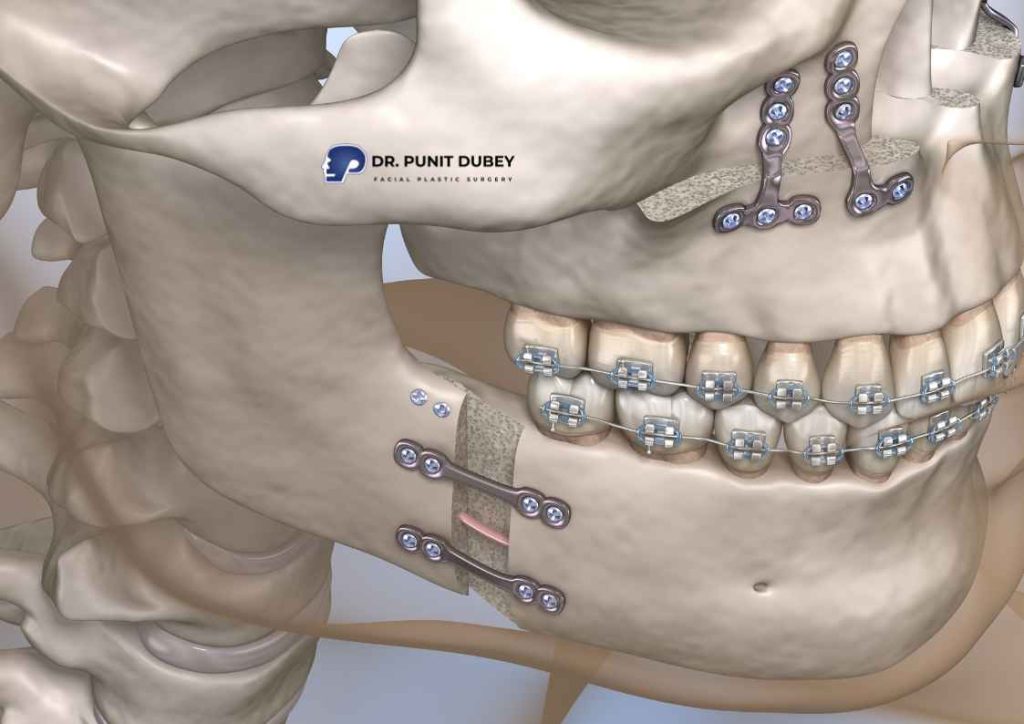
Factors Affecting the Cost
The total cost of obstructive sleep apnea surgery in India depends on several variables:
- Type of procedure (MMA, genioplasty, or combined surgeries)
- Pre-surgical orthodontics, if required
- Hospital stays and surgical facility charges
- Surgeon’s expertise and experience
- Location of the hospital or clinic (Delhi is more cost-effective than metros like Mumbai or Bangalore)
- Post-operative medications, diagnostics, and follow-up care
Average Cost Breakdown in India
- Maxillomandibular Advancement Surgery (Double Jaw Surgery): ₹2,50,000 to ₹4,50,000
- Genioglossus Advancement or Single Jaw Surgery: ₹1,50,000 to ₹2,50,000
- Comprehensive surgical packages (with pre- and post-op care): ₹3,00,000 to ₹5,00,000
These rates are significantly lower than what you’d expect to pay in the US or Europe, where the same procedure can cost ₹15 to ₹25 lakhs or more.
Obstructive Sleep Apnea Surgery Cost in Delhi
Delhi uniquely combines reasonable pricing with excellent clinical results. Typically:
- The cost of surgical treatment in Delhi generally falls between ₹2.25 lakhs and ₹4.25 lakhs, depending on the specifics of the case
- Inclusive packages often cover anesthesia, implants/plates, ICU care, and recovery monitoring
It’s not just cost-effective — it’s also value-packed, especially when performed by specialized surgeons like Dr. Punit Dubey.
Jaw Surgery for Sleep Apnea Before and After: Real-Life Transformations
The results of jaw surgery for obstructive sleep apnea aren’t just seen on a sleep study report — they’re felt every single day. From waking up refreshed to breathing deeply through the night, patients who undergo Maxillomandibular Advancement (MMA) often describe it as a rebirth of their quality of life.
Functional Improvements
Before surgery, many patients:
- Suffer from daytime fatigue, brain fog, and irritability
- Are dependent on CPAP machines
- Ongoing sleep disturbances can contribute to heightened levels of stress and anxiety
- Experience cardiovascular complications, high blood pressure, or low oxygen saturation
After surgery, most report:
- AHI scores dropping from 40–50+ to <5 (often into normal range)
- Discontinuation or major reduction in CPAP use
- Dramatic improvement in energy, mood, and focus
- Better blood pressure control and heart health
Visual Transformations
While the focus is medical, patients also undergo a positive facial transformation:
- A more balanced, defined jawline
- Correction of a weak chin or underbite
- Improved lip posture and breathing through the nose
These subtle aesthetic changes often boost self-esteem and confidence, especially for those with previous skeletal imbalances.
Real Stories, Real Change
Patients who were once trapped in a cycle of snoring, shallow sleep, and fatigue find themselves:
- Sleeping 6–8 hours without interruption
- Waking up clear-headed and motivated
- Living without dependency on machines or medications
Some even refer to their post-surgery phase as “the first real sleep of my adult life.”
If you’re hesitant about surgical treatment, these before and after stories can offer both evidence and inspiration.
FAQs on Obstructive Sleep Apnea Treatment in India
Can jaw surgery fix sleep apnea permanently?
Yes. Maxillomandibular Advancement (MMA) is considered the most effective surgical treatment for moderate to severe obstructive sleep apnea. By expanding the upper airway, it addresses the structural cause and often eliminates the need for CPAP altogether.
How much does jaw surgery cost for sleep apnea in India?
On average, jaw surgery for sleep apnea in India costs between ₹2.5 lakh to ₹4.5 lakh, depending on the surgeon, city, hospital, and whether it’s single or double jaw advancement. Delhi is often the most cost-effective choice without compromising on quality.
Is Maxillomandibular Advancement Surgery safe?
Yes, when performed by a skilled and experienced surgeon, MMA surgery is generally safe. Risks exist, as with any surgery, but complications are rare and manageable with proper post-op care.
What is the success rate of MMA surgery for OSA?
Clinical studies show 85–90% success rates, especially in patients with skeletal abnormalities. Most patients experience a significant drop in AHI and can stop using CPAP devices after surgery.
How long is the recovery after jaw surgery for OSA?
Most patients stay in the hospital for 2–3 days and resume light activities in 2–3 weeks. Full recovery, including bone healing and return to regular diet, may take 6–8 weeks.
Can children undergo surgery for sleep apnea?
Surgery for children is approached differently and usually focuses on tonsillectomy, adenoidectomy, or orthodontic expansion. MMA is typically reserved for adults or late adolescents with structural skeletal issues.
Will my facial appearance change after MMA surgery?
Yes, but positively. The advancement of the jaws often enhances facial balance — improving chin projection, jawline definition, and midface support, all while correcting airway obstruction.

